Have you ever noticed your child being distant? For example, instead of interacting with family members, teachers, or kids their age, they prefer to stay in the corner. If so, teaching self-initiation skills may be able to help.
Self-initiation can help your child improve these skills and become more open to effective communication.
What is Self-Initiation?
They are social interactions that your child initiates independently. That means that they started a conversation and opened a dialogue to interact with others.
Self-initiations aren’t simple responses to the efforts of teachers and peers. They’re those moments when your child takes the reigns to communicate without being prompted.
How it Benefits Your Child
Self-initiations can do a lot to improve your child’s overall social skills. They teach them to be more proactive about communication and more accepting of the back-and-forth that it entails.
Not only that, but self-initiations can motivate kids to engage in cooperative interactions. It facilitates sharing and collaborative play.
These skills come naturally and have a massive impact in the long run.
Types of Self-Initiations You Can Teach
In ABA Therapy, there are several types of self-initiations. Here are the most common that your child can learn and use in their everyday life.
Greetings
Greetings involve unprompted “Hellos” towards peers, teachers, and parents.
You can teach the action by encouraging your child to acknowledge people when they enter a room. They can also learn to identify people they know as they see them.
Requesting Items and Activities
This self-initiation strategy encourages your child to communicate a need. It involves asking others for access to items and activities. If the request is directed at a peer, it can also cement concepts of sharing, collaboration, and encourage communication and various social interactions.
Sharing and Showing
This allows your child to express their interests to others. It involves showing an item, action, or activity to another person.
There are many ways to teach your child to share. Adults can encourage the behavior by taking turns during a play session and reinforcing cooperative play. However, peer-based teaching can be effective, too.
Peers can model self-initiation, show them how to share effectively, and provide natural reinforcements.
Asking to Play
This activity encourages your child to ask someone to play and is another way to express needs and desires. It can apply to both adults and peers. With other kids, it can teach things like sharing, cooperation, and more.
Peers can help to teach this type of self-initiation. Appropriate peers can ask them to play first, show them the rules of the game, and more. Enjoying the play session will reinforce the behavior and encourage your child to be more vocal about requesting play on their own.
Commenting and General Communication
Any form of unprompted communication can classify as a self-initiation. Whether that’s making a comment or starting a dialogue, it’s a way to seek attention and begin a more extensive interaction.
The best way to teach this self-initiation is to encourage your child to ask more questions. Start small with simple WH-questions. Then, encourage your child to be more inquisitive with others to engage them in conversation.
Who Can Teach Self-Initiation Skills?
Both adults and young peers can teach your child self-initiations. Most of the adults that interact with your child can have some impact on their learning process. Everyone from teachers, behavioral therapists, and family members can reinforce these lessons.
Before they start, it’s important to identify the initiations your child needs to learn. Doing so can help you choose an ideal adult. For example, family members and close family friends are great for the early stages. They can be helpful when learning greetings, attention-focused actions, and more.
Peers can also provide valuable engagement and reinforcement. Regular interaction with others in a natural environment can lead to noticeable change. Just as adults, you must choose an appropriate peer to teach self-initiation. The right person can vary from one activity to the next, but more outgoing and socially accepting individuals are best.
Let’s say, for example, that you want to teach your kid to request activities or ask others to play. You can start by choosing an appropriate peer to play a game. Make sure the peer can provide praise and support. The goal is to reinforce social interactivity with the peer, so you should choose someone who will reciprocate and model the desired behaviors.
Teaching self-initiations is the first step to improving your child’s social skills. These actions teach your child to be more proactive and open to interactions. Before you know it, you may start to see improvements in how your child communicates with those around them. Those subtle initiations can have a significant impact on your child’s future.




